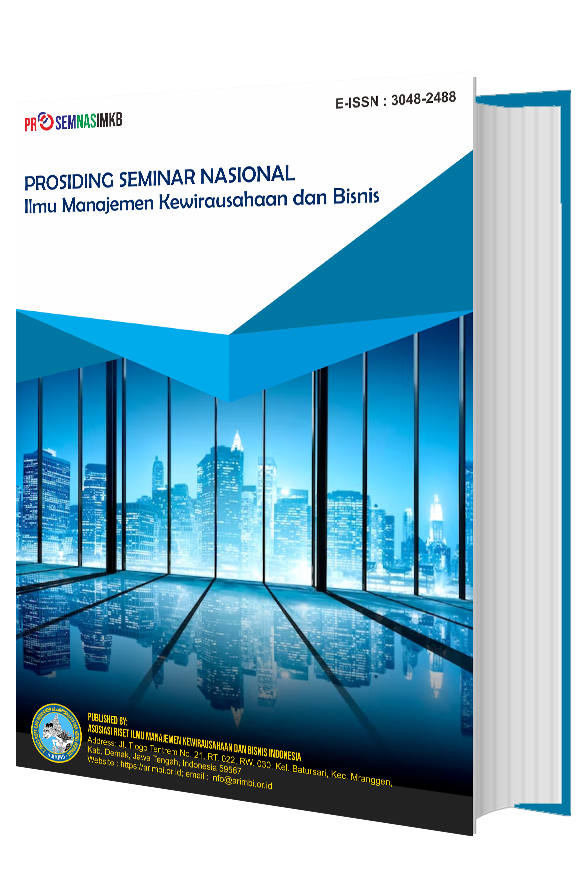Analisis Paparan Digital Fatigue Pada Generasi Z Untuk Mendukung Produktivitas Sehat di Era Digital
DOI:
https://doi.org/10.61132/prosemnasimkb.v2i2.206Keywords:
Digital fatigue, Generation Z, Digital media, Healthy ProductivityAbstract
The excessive and uncontrolled intensity of Gen-Z in using digital media through various communication and information platforms can impact mental/physical health, resulting in unhealthy productivity in various spheres of activity. This study aims to analyze the causes, impacts, and solutions of digital media exposure on the aspect of digital fatigue which is expected to provide a new approach for Gen-Z to develop professional attitudes and mindsets in using digital media. The research method in this study uses a qualitative descriptive method. The sampling technique in this study uses purposive sampling and snowball sampling techniques. The purposive sampling technique is determined by the age range of Gen-Z from STIE Pariwisata API Yogyakarta students born between the mid-1990s and early 2010s. The snowball sampling technique used is all 129 students. Data analysis is carried out descriptively based on the percentage of respondents' assessments from the available questions. The results of this study are, the higher the percentage of counterproductive causes, impacts, and solutions to the digital fatigue aspects chosen by respondents, the more unhealthy productivity will result, conversely, the lower the percentage of counterproductive causes, impacts, and solutions to the digital fatigue aspects chosen by respondents, the more healthy productivity will result. The contribution of this study is, to support the success of activities carried out through the use of digital media in accessing information and communication channels, Gen-Z must be able to make proportional choices, namely choices that are oriented towards mental/physical health so that they can place Gen-Z in a healthy productivity environment.
Downloads
References
Abedin, B., & Sundarasen, S. D. (2021). Digital transformation and sustainability of SMEs: A systematic review. Sustainability, 13(21), 11864. https://doi.org/10.3390/su132111864
Adams, R., Jeanrenaud, S., Bessant, J., Denyer, D., & Overy, P. (2016). Sustainability‐oriented innovation: A systematic review. International Journal of Management Reviews, 18(2), 180–205. https://doi.org/10.1111/ijmr.12068
Bai, C., Quayson, M., & Sarkis, J. (2021). Corporate sustainability development in the context of digitalisation: A review. Sustainable Production and Consumption, 26, 1439–1451. https://doi.org/10.1016/j.spc.2020.12.033
Bharadwaj, A., El Sawy, O., Pavlou, P., & Venkatraman, N. (2013). Digital business strategy: Toward a next generation of insights. MIS Quarterly, 37(2), 471–482. https://doi.org/10.25300/MISQ/2013/37:2.3
Bocken, N. M. P., Boons, F., & Baldassarre, B. (2020). Sustainable business model experimentation by understanding ecologies of business models. Journal of Cleaner Production, 295, 126361. https://doi.org/10.1016/j.jclepro.2020.126361
Braun, V., & Clarke, V. (2022). Thematic analysis: A practical guide. Sage. https://doi.org/10.1007/978-3-319-69909-7_3470-2
Creswell, J. W., & Poth, C. N. (2018). Qualitative inquiry and research design: Choosing among five approaches (4th ed.). Sage.
Dangelico, R. M., & Pujari, D. (2021). Mainstreaming green product innovation: Why and how companies integrate environmental sustainability. Journal of Business Ethics, 168(2), 1–26. https://doi.org/10.1007/s10551-019-04162-x
Elkington, J. (1997). Cannibals with forks: The triple bottom line of 21st century business. Capstone. https://doi.org/10.1002/tqem.3310080106
Goyal, P., Rahman, Z., & Kazmi, A. A. (2020). Corporate sustainability performance and firm performance research: Literature review and future research agenda. Management Decision, 58(8), 1682–1707. https://doi.org/10.1108/MD-09-2019-1321
Guest, G., Namey, E., & Chen, M. (2020). A simple method to assess and report thematic saturation in qualitative research. PLoS ONE, 15(5), e0232076. https://doi.org/10.1371/journal.pone.0232076
Hart, S. L. (1995). A natural-resource-based view of the firm. Academy of Management Review, 20(4), 986–1014. https://doi.org/10.5465/amr.1995.9512280033
Jain, S., & Singhal, S. (2022). Green practices for sustainable SMEs: A systematic literature review. Journal of Small Business Strategy, 32(1), 56–72.
Khan, S. A. R., Yu, Z., & Umar, M. (2021). Sustainable digitalization: A case of SMEs in emerging economies. Journal of Cleaner Production, 285, 124827.
Kraus, S., Palmer, C., Kailer, N., Kallinger, F. L., & Spitzer, J. (2019). Digital entrepreneurship: A research agenda on new business models for the twenty-first century. International Journal of Entrepreneurial Behavior & Research, 25(2), 353–375. https://doi.org/10.1108/IJEBR-06-2018-0425
Lim, W. M., Yap, S. F., & Makkar, M. (2021). Home-based businesses and digital technology: A systematic review. International Journal of Consumer Studies, 45(3), 373–389. https://doi.org/10.1111/ijcs.12628
Liu, Y., Wei, J., & Hu, J. (2021). Digital transformation and environmental innovation: Evidence from Chinese manufacturing firms. Technological Forecasting and Social Change, 166, 120636. https://doi.org/10.1016/j.techfore.2021.120636
Mahapatra, S., & Mishra, A. (2023). Digital green innovations for small businesses in Asia: Opportunities and challenges. Asia Pacific Business Review, 29(2), 201–220.
Maroufkhani, P., Wagner, R., & Wan Ismail, W. K. (2022). Green digital business strategy: Conceptualization and evidence from SMEs. Journal of Cleaner Production, 343, 130933. https://doi.org/10.1016/j.jclepro.2022.130933
Matarazzo, M., Penco, L., Profumo, G., & Quaglia, R. (2021). Digital transformation and customer value creation in Made in Italy SMEs: A dynamic capabilities perspective. Journal of Business Research, 123, 642–656. https://doi.org/10.1016/j.jbusres.2020.10.033
Merriam, S. B., & Tisdell, E. J. (2016). Qualitative research: A guide to design and implementation (4th ed.). Jossey-Bass.
Nidumolu, R., Prahalad, C. K., & Rangaswami, M. R. (2020). Why sustainability is now the key driver of innovation. Harvard Business Review, 98(5), 44–52.
Patton, M. Q. (2015). Qualitative research & evaluation methods (4th ed.). Sage.
Rahman, H., & Ahmad, Z. (2020). Environmental practices among SMEs in Kuala Lumpur. Asian Journal of Business and Management, 8(4), 122–135.
Sehnem, S., Vazquez-Brust, D., Pereira, S. C. F., & Campos, L. M. S. (2019). Circular economy: Benefits, impacts and overlapping. Supply Chain Management: An International Journal, 24(6), 784–804. https://doi.org/10.1108/SCM-06-2018-0213
SME Corp Malaysia. (2022). SME annual report 2021/22: Resurgence of SMEs. SME Corporation Malaysia.
Troise, C., Corvello, V., Ghobadian, A., & O'Regan, N. (2022). How can SMEs successfully navigate VUCA environment? The role of digital technologies. Technological Forecasting and Social Change, 174, 121278. https://doi.org/10.1016/j.techfore.2021.121278
Wirtz, J., Zeithaml, V. A., & Gistri, G. (2021). Technology-mediated service encounters. In P. P. Maglio, C. A. Kieliszewski, J. C. Spohrer, K. Lyons, L. Patricio, & Y. Sawatani (Eds.), Handbook of service science (Vol. II, pp. 377–401). Springer. https://doi.org/10.1007/978-3-030-72289-8_17
Downloads
Published
How to Cite
Issue
Section
License
Copyright (c) 2025 Prosiding Seminar Nasional Ilmu Manajemen Kewirausahaan dan Bisnis

This work is licensed under a Creative Commons Attribution-ShareAlike 4.0 International License.






